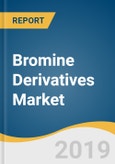The global bromine derivatives market size is projected to reach USD 5.11 billion by 2025, exhibiting a CAGR of 4.3% during the forecast period. Increasing installations of flame retardant electronics devices in the automotive sector are providing a fillip to the market. Brazil, Mexico, U.S., China, Saudi Arabia, Russia, and Norway have increased their oil & gas exploration activities. In such activities, calcium bromide (CaBr) and Sodium Bromide (NaBr) are used as drilling fluid for extraction of petroleum products. Therefore, the trend will stoke the growth of the market.
Raw material suppliers, product manufacturers, and end users are the part of value chain of the bromine derivatives market. Major manufacturing players in the bromine derivatives market include Albemarle Corporation, Lanxess, Chemtura Corporation, Israel Chemicals Ltd., Gulf Resources, Perekop Bromine, Albemarle Corporation, Sanofi S.A., and Tata Chemicals. To reduce time and costs involved in supply of materials, manufacturing facilities of raw material manufacturers are located in close proximity to bromine deposits.
Hydrobromic acid and calcium bromide are two key derivatives of bromine. Hydrobromic acid is used in the manufacturing of inorganic products such as zinc, sodium, and potassium bromides. Diatomic molecule of hydrogen bromide is dissolved in aqueous water to prepare the acid.
Calcium bromide is produced by reaction of calcium oxide (CaO), calcium carbonate (CaCo3) with hydrobromic acid. It is used in drilling fluids, photography, and oxidizer for mercury emissions control. Apart from uses in flame retardants and oil & gas, bromine derivative applications also include the use of fumigants in perfumes, heavy brines, and other specialty chemicals.
Further key findings from the report suggest:
This product will be delivered within 1-3 business days.
Raw material suppliers, product manufacturers, and end users are the part of value chain of the bromine derivatives market. Major manufacturing players in the bromine derivatives market include Albemarle Corporation, Lanxess, Chemtura Corporation, Israel Chemicals Ltd., Gulf Resources, Perekop Bromine, Albemarle Corporation, Sanofi S.A., and Tata Chemicals. To reduce time and costs involved in supply of materials, manufacturing facilities of raw material manufacturers are located in close proximity to bromine deposits.
Hydrobromic acid and calcium bromide are two key derivatives of bromine. Hydrobromic acid is used in the manufacturing of inorganic products such as zinc, sodium, and potassium bromides. Diatomic molecule of hydrogen bromide is dissolved in aqueous water to prepare the acid.
Calcium bromide is produced by reaction of calcium oxide (CaO), calcium carbonate (CaCo3) with hydrobromic acid. It is used in drilling fluids, photography, and oxidizer for mercury emissions control. Apart from uses in flame retardants and oil & gas, bromine derivative applications also include the use of fumigants in perfumes, heavy brines, and other specialty chemicals.
Further key findings from the report suggest:
- The global bromine derivatives market volume was estimated at 898.1 kilotons in 2017. It is poised to rise at a CAGR of 3.3% from 2018 to 2025.
- Tetrabromobisphenol A accounted for the largest market share of more than one fourth of the overall revenue in 2017. It is mainly used as a reactive component in polymer manufacturing
- Major players have adapted technologies that help in having a flexible production model so that they can benefit from existing infrastructure. Several processes are being developed for the manufacture from green chemical to reduce toxicity of end chemicals
- Bromine derivatives are majorly available in the form of solids and liquids. They are majorly used in manufacture of flame retardants and drilling fluids
- Some of the key participants are Albemarle, Lanxess, and Israel Chemicals Ltd.
This product will be delivered within 1-3 business days.
Table of Contents
Chapter 1 Methodology and Scope
Chapter 2 Executive Summary
Chapter 3 Bromine Derivatives Market Variables, Trends & Scope
Chapter 4 Bromine Derivatives Market: Product Estimates & Trend Analysis
Chapter 5 Bromine Derivatives Market: Application Estimates & Trend Analysis
Chapter 6 Bromine Derivatives Market: Regional Estimates & Trend Analysis
Chapter 7 Competitive Landscape
Chapter 8 Company Profiles
Companies Mentioned
- Albemarle Corporation
- Tata Chemicals Ltd.
- Lanxess Corporation
- Honeywell International Inc.
- Tosoh Corporation
- Israel Chemicals Limited
- Tetra Technologies Inc.
- Hindustan Salts Ltd.
- Jordan Bromine Company Ltd.
- Morre-Tec Industries, Inc.
- Beacon Organosys
- JK Chemicals
- Parad Chem Corporation
- ICC Industries
- Gulf Resources Inc.
- Agrocel Industries Ltd.
- Kingboard Chemical Holdings Limited
- Sontara Organo Industries
- Nirma Limited
- Neogen Chemicals Limited
Methodology

LOADING...








